World-Architects at ICFF
- Author
- John Hill
- Published on
- May 27, 2013
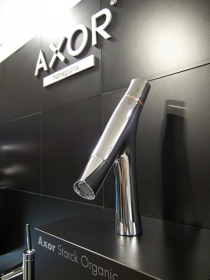
Axor Starck Organic. All photos by John Hill/World-Architects
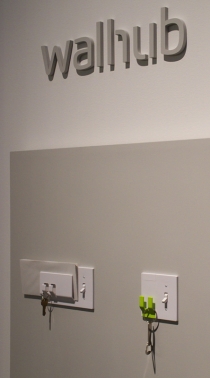
Wallhub by Upwell Design
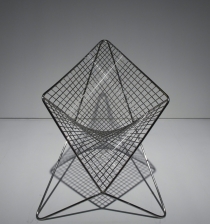
Parabola Chair designed by Carlo Aiello
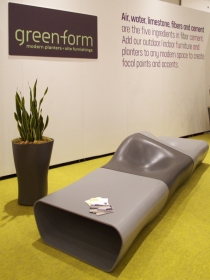
Greenform's Dune modular outdoor seating
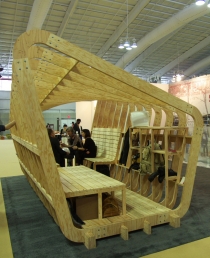
University of Cincinnati's "Flat Pack" relief shelter
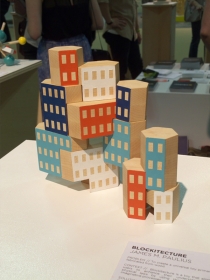
"Blockitecture" winner of RIT's metaproject 3
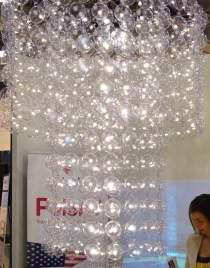
Puff Buff's inflatable PVC "Bubble" chandelier
World-Architects attended the 2013 International Contemporary Furniture Fair (ICFF) last week at the Jacob K. Javits Convention Center in New York City. Here we bring you some of our favorite designs, be they products, booths, or even noticeable trends.
The day before the ICFF kicked off, Axor hosted a party where they unveiled a new faucet design (below) by longtime compatriot Philippe Starck. Axor Starck Organic (left) departs from traditional faucets in a few ways: It uses less than half of the water of typical faucets (0.9 gpm versus 2.5 gpm) via a unique nozzle design; the temperature control is preset and color-coded; and the on/off control is located on the nozzle, meaning water drips into the bowl rather than on the rest of the sink. Admittedly, at first glance it appeared that the Organic monicker merely referred to the branch-like form of the faucet, so we were glad to learn of the ecological benefits of a design that aims at conserving the precious resouce of water.
The day before the ICFF kicked off, Axor hosted a party where they unveiled a new faucet design (below) by longtime compatriot Philippe Starck. Axor Starck Organic (left) departs from traditional faucets in a few ways: It uses less than half of the water of typical faucets (0.9 gpm versus 2.5 gpm) via a unique nozzle design; the temperature control is preset and color-coded; and the on/off control is located on the nozzle, meaning water drips into the bowl rather than on the rest of the sink. Admittedly, at first glance it appeared that the Organic monicker merely referred to the branch-like form of the faucet, so we were glad to learn of the ecological benefits of a design that aims at conserving the precious resouce of water.
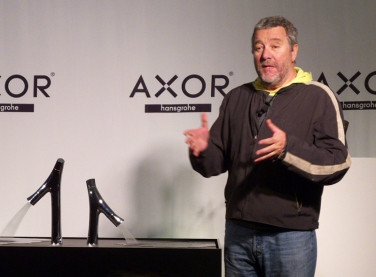
Philippe Starck unveiling the Axor Organic faucet
A product we're looking forward to is Keiou Design Lab's line of interior wall panels (below) made from Dapli, a pourable stone material they developed that is made from fine-grained pure white jade and other natural minerals. Their booth exhibited a number of the patterns they envision, but custom designs will be possible. The product is currently in the prototype stage.
One of our favorite products is the simple but brilliant Wallhub from Upwell Design (left), which lets switch plates do double duty as hooks for keys or umbrellas and slots for mail. The cover plates fit standard switches and can be flipped to right or left hand through the detachable hooks.
One of our favorite products is the simple but brilliant Wallhub from Upwell Design (left), which lets switch plates do double duty as hooks for keys or umbrellas and slots for mail. The cover plates fit standard switches and can be flipped to right or left hand through the detachable hooks.
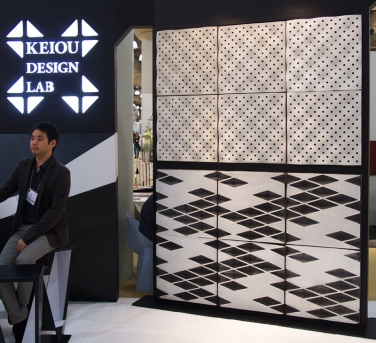
Keiou Design Lab's interior wall panels
Carlo Aiello, editor of eVolo Magazine, displayed his Parabola Chair (left) as part of the ICFF Studio, "a platform to match selected emerging designers and their prototype products with potential manufacturers." The chair was more comfortable than I imagined at first glance.
For outdoor seating, Greenform's Dune modular furniture system (left), designed by Rainer Mutsch, cut a great profile. As a bonus, the seating is made from 100% recycled fiber cement, so they are weatherproof and lightweight.
Since the fair floor is covered with booths displaying design company's latest wares, it's refreshing to see a display where the product IS the booth. Such is the case with Caesarstone's Stone Garden (below), made up of single-leg tables done in a collaboration with Japanese design firm Neno. The pebble-shaped tables need to be grouped into at least three to stand properly, and the scattering of dozens of them across the floor made quite an impression.
For outdoor seating, Greenform's Dune modular furniture system (left), designed by Rainer Mutsch, cut a great profile. As a bonus, the seating is made from 100% recycled fiber cement, so they are weatherproof and lightweight.
Since the fair floor is covered with booths displaying design company's latest wares, it's refreshing to see a display where the product IS the booth. Such is the case with Caesarstone's Stone Garden (below), made up of single-leg tables done in a collaboration with Japanese design firm Neno. The pebble-shaped tables need to be grouped into at least three to stand properly, and the scattering of dozens of them across the floor made quite an impression.
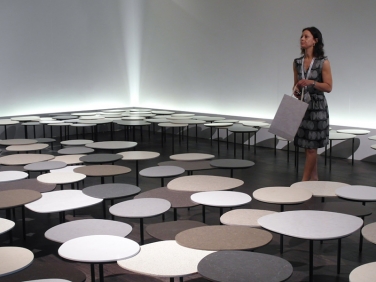
Caesarstone's Stone Garden by Neno
Student work was relegated to the north hall at Javits, and a couple of the standouts were the University of Cincinnati's "Flat Pack" relief shelter and "Blockitecture" (both at left), the winning design in Rochester Institute of Technology's metaproject, which asked students "to create a universal toy primarily fabricated from wood."
A couple of the noticeable trends in the show were inflatables and games for grown-ups. The former could be seen in the inflatable seating from Blofield Air Design (below left)—apparently ideal for camping—as well as Puff Buff's inflatable lighting (left). Games were in evidence all over the fair, geared to the informal work environments that are cropping up these days in tech and other offices. Ping pong and foosball tables, like the ones from RS Barcelona (below right), were easily the most popular playtime designs.
A couple of the noticeable trends in the show were inflatables and games for grown-ups. The former could be seen in the inflatable seating from Blofield Air Design (below left)—apparently ideal for camping—as well as Puff Buff's inflatable lighting (left). Games were in evidence all over the fair, geared to the informal work environments that are cropping up these days in tech and other offices. Ping pong and foosball tables, like the ones from RS Barcelona (below right), were easily the most popular playtime designs.
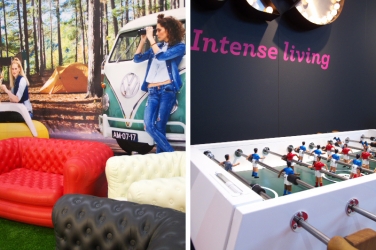
Left: Blofield Air Design by Stop Spot; Right: Foosball table from RS Barcelona
A number of booths catered to the rapidly growing popularity of digital fabrication. These ranged from small machines that could be purchased for use in an office to large and fairly loud machines that showed the potential of fabrication services. One of the latter was SCM Group's "I Wood Like - handmade & digital crafting" booth (below). When I visited, the machine was transforming a block of wood into a small car.
In a jarring—but most likely intentional—juxtaposition of high- and low-tech, nearby was a craft demonstration at the African & African-Caribbean Design Diaspora booth (bottom). That these technologies coexisted side-by-side at ICFF indicates that crafts of all sorts are a part of design, now and in the future.
In a jarring—but most likely intentional—juxtaposition of high- and low-tech, nearby was a craft demonstration at the African & African-Caribbean Design Diaspora booth (bottom). That these technologies coexisted side-by-side at ICFF indicates that crafts of all sorts are a part of design, now and in the future.
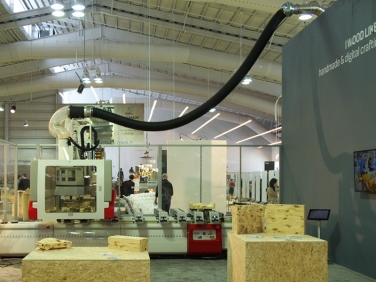
SCM Group's woodworking machinery
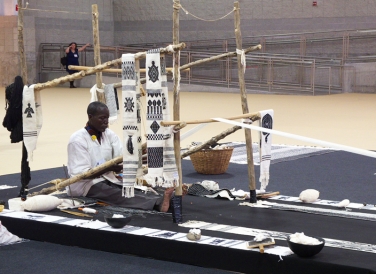
Craft demonstration at the booth of the African & African-Caribbean Design Diaspora